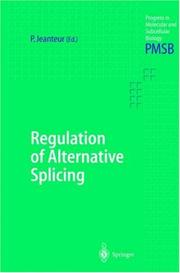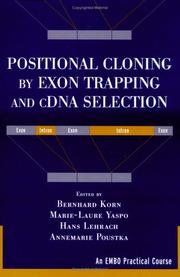| Listing 1 - 10 of 14 | << page >> |
Sort by
|

ISBN: 3540438335 Year: 2003 Publisher: Berlin : Springer-Verlag,
Abstract | Keywords | Export | Availability | Bookmark
 Loading...
Loading...Choose an application
- Reference Manager
- EndNote
- RefWorks (Direct export to RefWorks)
Exons (Genetics). --- Genetic recombination. --- Split genes.

ISBN: 0471297976 Year: 1999 Publisher: Heidelberg : New York, NY : SPEKTRUM [Elsevier], John Wiley,
Abstract | Keywords | Export | Availability | Bookmark
 Loading...
Loading...Choose an application
- Reference Manager
- EndNote
- RefWorks (Direct export to RefWorks)
Gene amplification. --- DNA, Complementary. --- Exons --- Polymerase chain reaction --- Exons --- Polymerase chain reaction
Dissertation
Year: 1997 Publisher: Alblasserdam Haveka
Abstract | Keywords | Export | Availability | Bookmark
 Loading...
Loading...Choose an application
- Reference Manager
- EndNote
- RefWorks (Direct export to RefWorks)
Cosmids --- Exons --- Genetic Techniques --- Genome --- Cloning, Molecular --- Globins --- methods --- genetics
Book
ISBN: 0192861549 Year: 1992 Publisher: Oxford Oxford University Press
Abstract | Keywords | Export | Availability | Bookmark
 Loading...
Loading...Choose an application
- Reference Manager
- EndNote
- RefWorks (Direct export to RefWorks)
Molecular biology --- Medical genetics --- Molecular genetics --- Exons (Genetics) --- Introns --- Genetics, Medical --- Genome, Human --- Exons --- Popular works --- physiology --- Human Genome Project
Dissertation
Abstract | Keywords | Export | Availability | Bookmark
 Loading...
Loading...Choose an application
- Reference Manager
- EndNote
- RefWorks (Direct export to RefWorks)
Genetic Therapy --- Muscle Cells --- Muscular Dystrophy, Duchenne --- Oligonucleotides, Antisense --- Exons. --- Dystrophin --- Mini-Exon --- Exon --- Mini Exon --- Mini-Exons --- Exome --- methods. --- metabolism. --- therapy. --- genetics. --- Theses --- Exons --- methods --- metabolism --- therapy --- genetics
Book
ISBN: 9039309442 Year: 1994 Publisher: Utrecht Universiteit Utrecht
Abstract | Keywords | Export | Availability | Bookmark
 Loading...
Loading...Choose an application
- Reference Manager
- EndNote
- RefWorks (Direct export to RefWorks)
Exons --- Insulin-Like Growth Factor II --- Protein Sorting Signals --- Protein Biosynthesis --- RNA, Messenger --- physiology --- genetics
Book
ISBN: 0465021689 Year: 1991 Publisher: New York, N.Y. BasicBooks
Abstract | Keywords | Export | Availability | Bookmark
 Loading...
Loading...Choose an application
- Reference Manager
- EndNote
- RefWorks (Direct export to RefWorks)
Book
Year: 2021 Publisher: Basel, Switzerland MDPI - Multidisciplinary Digital Publishing Institute
Abstract | Keywords | Export | Availability | Bookmark
 Loading...
Loading...Choose an application
- Reference Manager
- EndNote
- RefWorks (Direct export to RefWorks)
The exploitation of biodiversity is essential to select resilient genotypes for sustainable cropping systems as one of the main challenges for plant breeding. Mapping traits of agronomic interest in specific genomic regions appears as another pivotal effort for the future development of novel cultivars. For this purpose, there is evidence that MAGIC and other exotic populations will play a major role in the coming years in allowing for impressive gains in plant breeding for developing new generations of improved cultivars. This Special Issue focused on the application of advanced technologies devoted to crop improvement and exploit the available biodiversity in crops. In detail, next-generation sequencing (NGS) technologies supported the development of high-density genotyping arrays for different plants included in this issue.
Research & information: general --- natural variation --- maize --- nucleotide diversity --- domestication selection --- ZmPGP1 gene --- Ipomoea batatas --- genetic diversity --- SSR markers --- qualitative traits --- pure lines --- F1 hybrids --- microsatellite markers --- marker-assisted breeding --- crop improvement --- varieties --- Fragaria --- Rubus --- microsatellites --- transferability --- polymorphism --- introns --- exons --- flavonoid biosynthesis pathway --- transcription factor genes --- chitinase --- multiple population --- linkage mapping --- JLAM --- QTL --- validation --- genomic prediction --- maize lethal necrosis --- herbaceous peony --- molecular marker --- next-generation sequencing --- pedigree --- Vicia faba L., genetic diversity --- in situ conservation --- Olea europaea L. --- olive --- cpSSR --- nuSSR --- population structure --- Mediterranean Region --- GWAS --- drought --- barley --- spikelet development --- candidate gene --- linkage map --- RAD --- Solanum melongena --- n/a
Book
ISBN: 0691002509 Year: 1997 Publisher: Princeton (N.J.): Princeton university press
Abstract | Keywords | Export | Availability | Bookmark
 Loading...
Loading...Choose an application
- Reference Manager
- EndNote
- RefWorks (Direct export to RefWorks)
Cancer has become the scourge of the twentieth century. It was always part of the human condition, but until recently it was not a common cause of death because most people died from the infectious diseases. Now that so many of us will live long enough to develop cancer, we need to learn as much about it as we can. This requires some understanding of molecular biology. John Cairns has made significant contributions to cancer research, molecular biology, and virology. He believes that it is possible to explain what is known about cancer and about molecular biology in terms that are easily understood by people with little or no scientific training. In this fascinating book, he explores the revolution in public health, the origins and principles of molecular biology, and our emerging understanding of the causes of cancer. Finally, he discusses how these developments are likely to affect future generations. As Cairns points out, the last two hundred years have altered our life expectations beyond all recognition. Even in the less developed nations of the world, people are starting to believe that everyone ought to be able to live into old age and be protected from the major causes of premature death. This change in our expectations is one of the major benefits of technology and the biological sciences. But the resulting explosion in the human population ultimately threatens everything we have gained by scientific progress.
Cancer. --- Life (Biology) --- Molecular biology. --- Ephrussi, Boris. --- Frederick the Great. --- Hodgkin’s disease. --- Jefferson, Thomas. --- Jenner, Edward. --- Koch, Robert. --- Lacks, Henrietta. --- Nirenberg, Marshall. --- Pap smears. --- Pauling, Linus. --- adenovirus oncogenes. --- alkaptonuria. --- allostery. --- antibiotics. --- base-pairing in DNA. --- blender experiment. --- blood-letting. --- brain development. --- catalysis. --- causality. --- chromatography. --- clinical trials. --- contact inhibition. --- dating by radio-isotopes. --- demographic transition. --- differentiation. --- exons. --- feathers. --- fossils and evolution. --- gap junctions. --- genetic code. --- genetic engineering. --- genetic maps. --- greenhouse effect. --- hemoglobin. --- homeotic genes. --- in vitro tranformation. --- keratin. --- life on earth, origin of. --- macromolecules. --- macroparasitism. --- malignant melanoma. --- melanocyte migration. --- mobile genetic elements. --- nasopharyngeal cancer. --- nucleic acid hybridization. --- oncogenes. --- operators. --- ovarian cancer. --- penicillin production. --- pheromones. --- probability. --- promoters.
Book
Year: 2021 Publisher: Basel, Switzerland MDPI - Multidisciplinary Digital Publishing Institute
Abstract | Keywords | Export | Availability | Bookmark
 Loading...
Loading...Choose an application
- Reference Manager
- EndNote
- RefWorks (Direct export to RefWorks)
The exploitation of biodiversity is essential to select resilient genotypes for sustainable cropping systems as one of the main challenges for plant breeding. Mapping traits of agronomic interest in specific genomic regions appears as another pivotal effort for the future development of novel cultivars. For this purpose, there is evidence that MAGIC and other exotic populations will play a major role in the coming years in allowing for impressive gains in plant breeding for developing new generations of improved cultivars. This Special Issue focused on the application of advanced technologies devoted to crop improvement and exploit the available biodiversity in crops. In detail, next-generation sequencing (NGS) technologies supported the development of high-density genotyping arrays for different plants included in this issue.
natural variation --- maize --- nucleotide diversity --- domestication selection --- ZmPGP1 gene --- Ipomoea batatas --- genetic diversity --- SSR markers --- qualitative traits --- pure lines --- F1 hybrids --- microsatellite markers --- marker-assisted breeding --- crop improvement --- varieties --- Fragaria --- Rubus --- microsatellites --- transferability --- polymorphism --- introns --- exons --- flavonoid biosynthesis pathway --- transcription factor genes --- chitinase --- multiple population --- linkage mapping --- JLAM --- QTL --- validation --- genomic prediction --- maize lethal necrosis --- herbaceous peony --- molecular marker --- next-generation sequencing --- pedigree --- Vicia faba L., genetic diversity --- in situ conservation --- Olea europaea L. --- olive --- cpSSR --- nuSSR --- population structure --- Mediterranean Region --- GWAS --- drought --- barley --- spikelet development --- candidate gene --- linkage map --- RAD --- Solanum melongena --- n/a
| Listing 1 - 10 of 14 | << page >> |
Sort by
|

 Search
Search Feedback
Feedback About UniCat
About UniCat  Help
Help News
News